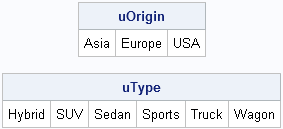More than a month ago I wrote a first article in response to an interesting article by Charlie H. titled Top 10 most powerful functions for PROC SQL. In that article I described SAS/IML equivalents to the MONOTONIC, COUNT, N, FREQ, and NMISS Functions in PROC SQL.
In this article, I discuss the UNIQUE functions in PROC SQL and in PROC IML.
The UNIQUE function in SQL finds the unique values of a variable. For categorical variables, it gives the levels of the variable. Charlie H. wrote a program that uses PROC SQL to count the number of levels for the Origin and Type variables in the SASHELP.CARS data set:
proc sql; title'Unique() -- Find levels of categorical variables'; select count(unique(Origin)) as L_origin, count(unique(Type)) as L_type from sashelp.cars; quit; |

The SAS/IML language also has a UNIQUE function. The UNIQUE function always returns a row vector that contains the unique sorted values of its argument, as shown in the following statements:
proc iml;
use sashelp.cars;
read all var {Origin Type};
close sashelp.cars;
uOrigin = unique(Origin);
uType = unique(Type);
print uOrigin, uType; |

Because you know that the output is a row vector, you can count the number of columns by using the NCOL function, as shown below:
L_Origin = ncol(uOrigin); /** = 3 **/ L_Type = ncol(uType); /** = 6 **/ |
I think that the UNIQUE function is one of the most important functions in SAS/IML because it enables you to compute statistics for each level of a categorical variable. Furthermore, the UNIQUE/LOC technique (which is described on p. 69 of my book, Statistical Programming with SAS/IML Software) is a highly useful technique that should be a part of every statistical programmer's toolbox.

1 Comment
Hi, Rick!
Thank you for your article!
I am wondering, what is the main difference between count(unique(var)) and count(distinct var) in SQL procedure.
Thank you!
Elena